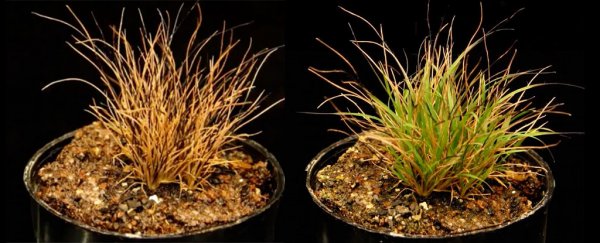Resurrection plants are freaky things. These remarkable species can survive without water for months or even years in desert environments, slowly shrivelling up to become dead-looking husks… until they get some water, that is, when they spring back to their former green glory in just hours or days.
But how do they pull off this amazing trick? Thanks to Australian researchers who have been studying the native grass Tripogon loliiformis, we now know what the key is to this Lazarus-like transformation: sugar.
Like other resurrection plants, T. loliiformis has the ability to withstand desiccation (being dried out) for long periods of time in between drinks. During drought-like conditions, it effectively plays dead, losing its volume and colour, as you can see in the image above.
But don't mistake its wan appearance for actual death. Even after losing 95 percent of its relative water content, the grass is still quite alive and capable of flourishing again when provided with water. Until now, however, scientists didn't understand how the regeneration worked. Does the existing plant wake up from a long sleep, as it were, or is the new growth separate from the old cells?
According to researchers from the Queensland University of Technology (QUT), the grass survives through a combination of sugar manipulation and controlled sacrifice of cells.
When hit by the stress of drought, T. loliiformis accumulates trehalose, a non-reducing sugar found in plants. The grass uses this sugar to trigger what's called autophagy, a process that allows for an orderly degradation and recycling of the plant's cells.
"The resurrection plant controls the levels of autophagy to prevent death upon drying," said one of the team, Sagadevan Mundree. "Presumably, once induced, autophagy promotes desiccation tolerance in the grass, by recycling nutrients and removing cellular toxins to suppress programmed cell death."
However, the plant is not equipped to continue this process indefinitely; prolonged drought stress could result in excessive autophagy, leading to a death that's more than just superficial.
The research, published in PLOS Genetics, could have a huge impact on future crop production if we can figure out how to replicate this ability in other plants, using candidate genes from species such as T. loliiformis to develop stress-tolerant crops.
With climate change threatening food supply and the world steadily losing its supply of arable land due to the continued use of intensive agricultural techniques, hardy plants that can survive for longer without water is something we'll very much need in the near future.
"Global climate change, increasingly erratic weather and a burgeoning global population are significant threats to the sustainability of future crop production, but resurrection plants present great potential for the development of stress tolerant crops," said QUT researcher Brett Williams. "It's an important step along a genetic path that we hope will lead to scientists being able to develop more robust crop varieties that can withstand the uncertainty of climate change whilst still producing maximum yields."
QUT are sponsors of ScienceAlert. Find out more about their research.
